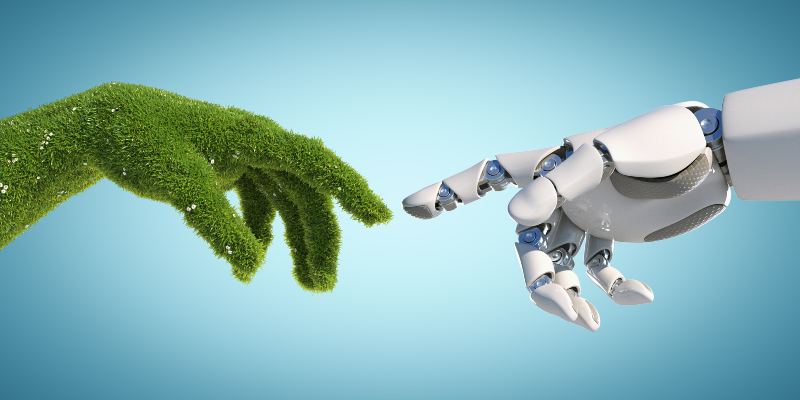Artificial Intelligence is the latest leading technological trend of this century, and like every other new technological innovation, it is revolutionizing every aspect of human life. Its influence on the economic, political, and social life of human beings on the local and international stage is becoming increasingly hard to overlook. Similarly, the environment is no exception to these changes. Since the first industrial revolution, technological advances have continuously impacted the environment. At first, human beings were not fully aware of the consequences of these advancements, but with the passage of time, these outcomes are becoming increasingly prominent. Times have changed now, and we can make more calculated predictions regarding the consequences of the latest advances; thus, with awareness, we can focus on prevention rather than future interventions. In this piece, we will first dig into the impacts of AI on the environment, and then we will analyze how, through proactive measures and ethical practices, we can effectively address these threats and work on a sustainable future in which AI can prevail without destroying the environment further.
Table of Contents
ToggleArtificial Intelligence and Environmental Costs:
The brilliance of Artificial Intelligence conceals the energy-intensive process it requires, which directly leads to the overwhelming carbon footprint it leaves behind. The more these new models and datasets become complex, the more energy is required to run and train AI models. This increase in consumption of energy instantly impacts greenhouse gas emissions, affecting climate change for the worse. OpenAI researchers claim that the computing power required to run and train AI models has been doubling every 3.4 months since 2012. It is believed that by 2040, the emissions of the Information and communication technology industry will reach around 14% of the global emissions majority of it deriving from the data centers and communication networks. It is extremely difficult to calculate the exact impacts AI will have on the climate crisis because the different types of AI need various quantities of energy to train and run. For example, machine learning models that spot trends in research data, AI that helps self-driving cars, and large language models all require different amounts of energy to operate. The generalized results of the research on popular AI models by the University of Massachusetts suggest that the training of such models produces around 626,000 pounds of carbon dioxide, which can be considered equivalent to around 300 trips between San Francisco. This highlights the urgent need to understand and address the major carbon footprint that the advancement in AI is leading to.
The consequences of advancement in AI on the environment do not stop at production but are also followed by processes and methods of disposal of old electronic waste. As the latest technology gets invented the old one is discarded, while many do not think twice about where this waste goes the hazardous chemicals it contains like lead, cadmium, and mercury contaminate the water and soil which further puts human health and the environment in danger. According to the World Economic Forum by 2050 the quantity of electronic waste will succeed 120 million metric tons. The impacts of AI on the environment do not end at these direct implications, another way we can see their impacts is by enhancing other environmentally unfriendly industries like fast fashion through automated AI-powered advertisements. To boost up the consumptive behavior the advertising algorithms organize bizarrely specific pop-up ads on social media platforms like Instagram and Facebook. In case of the fast fashion, the algorithm pushes cheap – mass-produced clothes that are meant to be replaced as soon as new trends arrive. This generates greater demand for the fast-fashion industries, adding to the emissions produced by this industry which is already responsible for up to eight percent of global emissions. Further, these impacts will start to become prominent in other areas like automatic driverless cars and delivery drones which will pose a threat to the animals and the environment. Using AI for agriculture can lead to the overuse of pesticides and fertilizers that will contaminate the water and soil for the sake of increasing yields. And let’s say if we use AI models to help manage environmental issues ethical questions are raised. The decisions made by AI systems could easily be biased based on the accuracy and type of the data used, for example, if the system is organized to be economically motivated it may choose to put short-term economic profits over long-term environmental sustainability.
Artificial Intelligence and Environmental Protection:
These negative implications of AI on the environment if not contained then at least can be reduced by adopting certain environmentally friendly measures. By aligning their algorithms with energy efficiency and using new streamlined networks, AI systems will be able to reduce their energy consumption. We have already established above that various types of AI systems require different quantities of energy. Thus, there is space to choose a less damaging system of AI, for example, eco-friendly data centers that utilize renewable energy that will decrease the carbon footprint. It is also very important to choose specific data samples and avoid repetitive data input while training AI to ensure that the AI system is not biased.
Even though AI is negatively impacting the environment, it does not mean that it cannot have its own positive implications. It can help organize and highlight data that assist in keeping track of climate change. For example, climate change has led to the destruction of one of the coldest places on Earth ‘The Antarctic’. With the help of AI, we can monitor the melting of icebergs 10,000 times faster than before. It can also help us ramp up the already existing environmentally sustainable projects like recycling, many items sent to be recycled do not get recycled, it is estimated that in 2021, around 85% of plastic end up in landfills in the United States. AI with its new technology can help regulate this process much more efficiently by keeping track of incoming items for facilities. Natural disaster destruction can be minimized by taking actions based on AI predictions regarding when and where these natural disasters will occur, giving time to prepare. Therefore, it is not wrong to say that AI can be used for either the destruction or protection of the environment depending on the choices we make.
Advancements in Artificial Intelligence inevitably triggered a chain reaction that impacts every aspect of human life and their surroundings. These impacts, whether they have materialized or just being predictions for now share the common characteristic of being shown as a significant threat. Regardless this does not mean that human beings have no power over the nature of these impacts being positive or negative. With the right interventions and preventions, humans can decide how AI will interact with them and their environment.

Ahwar Azhar
Ahwar Azhar is a Social Sciences graduate with a major in International Relations from Bahria University. Her writing explores the evolving dynamics of global politics, spanning the impact of emerging technologies like AI, environmental and gender politics, great power competition, and South Asian affairs.
- This author does not have any more posts.













